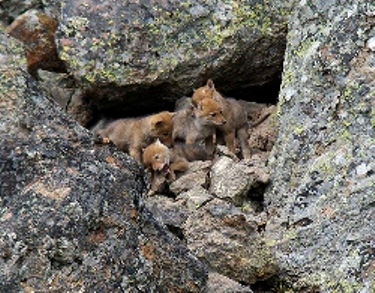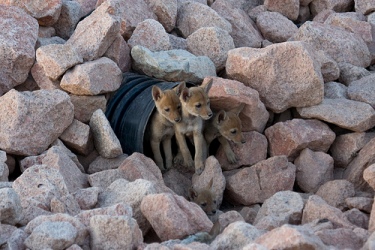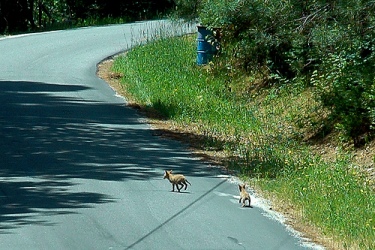
Reproduction
Reproduction in the coyote is a very delicate process, as
females are completely infertile for ten months out of the year,
and males are sterile for eight. The process begins with
several males vying for the attention of a single female.
However, unlike in many other species, they do this passively;
they linger near her for up to several weeks until the female
makes her choice for a mate. After she chooses, a complex
duet of howls between the two ensues, announcing this new bond
to any other coyotes within range. Coyotes appear to mate
for life, though this is difficult to confirm in wild
populations.
 Adults
breed some time during February and early March and after a
gestation period of roughly sixty-three days, the pups are
born. Females usually give birth to a litter of six to eight pups, but up to twelve have
been observed. Pups are dependent on their mother and the rest
of the pack for about fourteen weeks after they are born. As
they progress to solid food, their diet consists of small
animals brought back to the den and regurgitated food from these
older pack members. The young leave the den for the
first time at about two to three weeks, and are weaned at about
five to seven weeks, depending on the availability of meat.
Pups are playful and curious, but stay close to the den and dart
back in at a single warning bark from the mother.
Adults
breed some time during February and early March and after a
gestation period of roughly sixty-three days, the pups are
born. Females usually give birth to a litter of six to eight pups, but up to twelve have
been observed. Pups are dependent on their mother and the rest
of the pack for about fourteen weeks after they are born. As
they progress to solid food, their diet consists of small
animals brought back to the den and regurgitated food from these
older pack members. The young leave the den for the
first time at about two to three weeks, and are weaned at about
five to seven weeks, depending on the availability of meat.
Pups are playful and curious, but stay close to the den and dart
back in at a single warning bark from the mother.
 Adults
breed some time during February and early March and after a
gestation period of roughly sixty-three days, the pups are
born. Females usually give birth to a litter of six to eight pups, but up to twelve have
been observed. Pups are dependent on their mother and the rest
of the pack for about fourteen weeks after they are born. As
they progress to solid food, their diet consists of small
animals brought back to the den and regurgitated food from these
older pack members. The young leave the den for the
first time at about two to three weeks, and are weaned at about
five to seven weeks, depending on the availability of meat.
Pups are playful and curious, but stay close to the den and dart
back in at a single warning bark from the mother.
Adults
breed some time during February and early March and after a
gestation period of roughly sixty-three days, the pups are
born. Females usually give birth to a litter of six to eight pups, but up to twelve have
been observed. Pups are dependent on their mother and the rest
of the pack for about fourteen weeks after they are born. As
they progress to solid food, their diet consists of small
animals brought back to the den and regurgitated food from these
older pack members. The young leave the den for the
first time at about two to three weeks, and are weaned at about
five to seven weeks, depending on the availability of meat.
Pups are playful and curious, but stay close to the den and dart
back in at a single warning bark from the mother.
Although
six to eight pups are born, only about two survive
until the fall due to disease or predation by
eagles, owls,
rattlesnakes or various predatory mammals.
Unfortunately, pups are also a target of hunters and
ranchers concerned with "controlling" the coyote population.
With increasing numbers of coyotes making their homes closer
to urban areas, cars and trains also play a large role in
the mortality rates of young coyotes.
fall due to disease or predation by
eagles, owls,
rattlesnakes or various predatory mammals.
Unfortunately, pups are also a target of hunters and
ranchers concerned with "controlling" the coyote population.
With increasing numbers of coyotes making their homes closer
to urban areas, cars and trains also play a large role in
the mortality rates of young coyotes.
 fall due to disease or predation by
eagles, owls,
rattlesnakes or various predatory mammals.
Unfortunately, pups are also a target of hunters and
ranchers concerned with "controlling" the coyote population.
With increasing numbers of coyotes making their homes closer
to urban areas, cars and trains also play a large role in
the mortality rates of young coyotes.
fall due to disease or predation by
eagles, owls,
rattlesnakes or various predatory mammals.
Unfortunately, pups are also a target of hunters and
ranchers concerned with "controlling" the coyote population.
With increasing numbers of coyotes making their homes closer
to urban areas, cars and trains also play a large role in
the mortality rates of young coyotes.